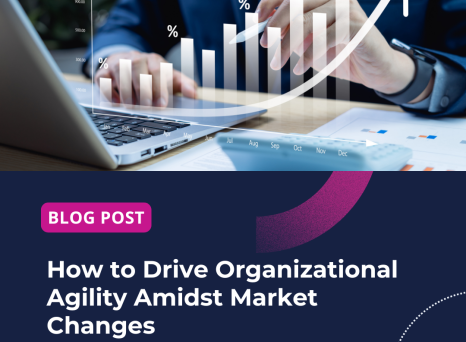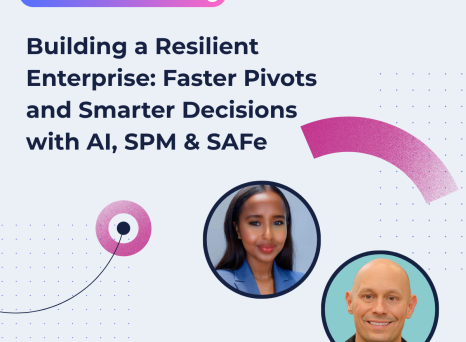IT budgets are finally under control. Deadlines are being met. On paper, Agile, and its scaled cousin, SAFe, have delivered what they promised. But has the problem truly been solved?
IT budgets are finally under control. Deadlines are being met. On paper, Agile, and its scaled cousin, SAFe, have delivered what they promised. But has the problem truly been solved?
In a recent conversation with the CIO of a major European bank, what started as a familiar tale of transformation took an unexpected turn. Yes, Agile brought speed and structure. Yes, SAFe helped scale those wins. But as the CIO candidly revealed, another challenge emerged. One harder to see, and harder still to fix: the loss of visibility into value.
In this article, Olivier Guimard, IT Product Owner at Planisware. examines what happens when organizations shift to Agile frameworks, and find themselves trading one kind of chaos for another. It's a cautionary tale about the deeper issue CIOs now face. How to regain control over what really matters: scope, outcomes, and trust in the value delivered?
The problem before Agile
Before adopting Agile, the bank’s IT projects were facing some well-known, almost textbook issues:
- Projects were often (if not always) over budget. The “how much” was out of control.
- Deadlines were routinely missed. The “when” took a back seat.
- But the “what”—the scope—was known and agreed upon from the beginning.
- And the quality? It met expectations. No surprises there.
In short: they consistently delivered on scope and quality, just late and over budget.
And surprisingly, that worked—at least for a time. In a relatively stable environment, where the pace of change wasn’t relentless, the business accepted delays and overspend as long as they got what they asked for.
From a top-management perspective, however, something fundamental was missing. According to the classic project management triangle—scope, time, and cost—they were always sacrificing one or two elements. The triangle was never fully in balance.
And then, things changed.
The Agile shift: faster markets, faster delivery
As the bank’s market evolved, speed became a strategic necessity. Competitors were moving faster, digital-first players were reshaping expectations, and customers no longer tolerated lengthy delivery cycles.
Agile was seen as the answer. A framework to drive faster delivery, more frequent value drops, and greater responsiveness to change.
But shifting to Agile was no small feat. Culturally, it was a heavy lift. The CIO admitted it took years to get both IT and business teams fully on board. And even today, some projects remain in the old waterfall model.
Eventually, though, they scaled Agile using SAFe. And on the surface, the results looked impressive:
- Projects were now delivered on time.
- Budgets were under control—at least annually. (Quarterly planning was still a work in progress.)
At this point in the conversation, I thought they had found the grail of IT project delivery—the elusive equation that balances on-time, on-budget, and on-scope outcomes.
So, case closed? Not quite.
The new pain: scope and value drift
Despite those clear wins, the CIO wasn’t celebrating. In fact, he was just as frustrated as before—but for very different reasons.
Agile had empowered his teams to take ownership of delivery: sprint planning, backlog grooming, iterative shipping of features. Budgets were controlled via upfront team allocation, and timelines were adhered to thanks to the fixed cadence of sprints.
But something critical was now missing: visibility into value.
Yes, the teams delivered. But delivered what? When? To whom? And with what impact?
Features arrived when they were ready, often unpredictably. There were no longer clear commitments on scope or benefits. The business couldn’t confidently forecast or communicate what they’d be getting—or when.
Instead of regaining control, Agile had created a new kind of opacity. The CIO had traded rigid planning for flexible execution, but lost line of sight on the outcomes.
Agile vs. Waterfall... or just better control?
And that’s why I met this CIO. He was looking for a solution—not to choose between Agile or Waterfall—but to regain control across all dimensions of delivery.
He wasn’t interested in debating frameworks. What he wanted was a way to:
- Monitor and control costs,
- Track and forecast timelines with confidence,
- Commit to a clear scope and measure progress against it,
And, above all, ensure that the business could understand and trust the value being delivered.
Because at the end of the day, methodology is just a means to an end. What really matters is the ability to deliver meaningful outcomes reliably, predictably, and transparently—especially when you're reporting to a CEO or CFO who wants clear answers, not frameworks.
Whether you're using Agile, SAFe, Waterfall, or a hybrid mix, the challenge is the same: How do you ensure alignment between what’s planned, what’s delivered, and what value it brings?
That’s the next frontier for CIOs—and for the tools and mindsets that support them.



